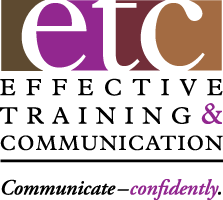(This month, we rerun a popular feature from last year. So, take a second look at Gestures.)
How good are your presentation gestures? Want to find out? I see a lot of hands up, so let’s start with a brief summary of Gesturing ‘Worst Practices’. It should be an interesting and mildly amusing trip, but may hit too close to home. Then next month, we’ll focus on Best Practice skills to fix the problems.
A Physiology Primer
- That excess nervous energy from Presentation Anxiety finds a warm and happy place to hide in your hands. That’s why nervous presenters often get the shakes. Trembling or fidgety hands or fingers are telltale signs of nervousness … and reduce your sizzle.
- The eyes of the audience are usually drawn to movement. When your hands are moving, the audience is compelled to look at them. If they are sending out a non-verbal message of ‘I’m nervous’, the audience can’t help but notice.
- Gestures can add visual value and sizzle to your message … or detract from it. Presenters with ineffective or distracting gestures don’t consciously plan them that way. They result from unconscious bad habits.
Worst Practices
That all said, here’s what you shouldn’t do with your hands because these habits throw cold water on your sizzle:
- Not gesturing at all – humans generally gesture when they talk. Just watch a casual stand-up conversation from a bit of a distance. Since presenting is talking, not gesturing looks odd and unnatural. The longer you go without some kind of gesture, the more conspicuous and distracting it becomes.
- Gesturing too much – the opposite extreme can also distract and annoy your audience. Such a distraction gets in the way of your message and quickly erodes your image of credibility.
- Overdoing the same gesture – even if the gesture itself is not done too much, using the same one all the time can really impact your audience. That same point, jab or chop can dominate their attention to the point that they begin counting them.
- Fidgety movements – an entire family of unproductive hand or finger movements that add nothing to your message or image and only project nervousness, lack of confidence and credibility.
- Putting your hands together – they’re like ‘vel’ and ‘cro’. Once you put them together, you can’t get them apart. While this may make you feel more calm and comfortable, it doesn’t project power or confidence.
- Counting on your fingers – really? So trite and corny. Your audience doesn’t need you to be that obtuse. They can still get it when you use a more subtle transition from point #1 to point #2 than holding up two fingers.
- Hands behind your back – this action renders these natural visual aids powerless and looks like you’re hiding something. You are.
- Hands together in front/‘fig leaf’ position – remember that the eyes of your audience are drawn to your hands and movement. Is that where you want them to look? I didn’t think so.
- Both hands in your pockets – often an unconscious action to remove the fidgety hand movements from sight. Unfortunately, it looks exactly like that. If you continue the fidgets, it makes your pockets look like you brought your pet hamster with you to the presentation. Or, you start jingling the change in your pocket, which they can hear.
- One hand in your pocket – while projecting a more relaxed and casual image, you just lost one half of your visual aids. So, a little goes a long way.
If these Gesturing Worst Practices sounded too much like you, ask yourself why you do those things. If you’re not really happy with your answer, your audience won’t be either.
